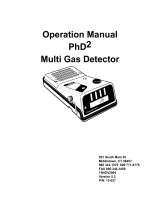Ventis® MX4 Product Manual
© 2020 Industrial Scientific Corporation i
Contents
►Copyright Notice ........................................................................................................................................ 1
►Warnings and Cautionary Statements ....................................................................................................... 1
General .......................................................................................................................................................... 1
Personnel ...................................................................................................................................................... 1
Hazardous Conditions, Poisons, and Contaminants .................................................................................... 1
General Usage .............................................................................................................................................. 2
Agency-issued Conditions of Use and Warnings .......................................................................................... 2
Recommended Practices .............................................................................................................................. 3
►Ventis MX4 Resources .............................................................................................................................. 3
►Ventis MX4 Capabilities ............................................................................................................................. 3
►Unpacking the Monitor ............................................................................................................................... 4
Contents ........................................................................................................................................................ 4
Hardware Features and Functions ................................................................................................................ 5
Display Screen .............................................................................................................................................. 6
Alarms ........................................................................................................................................................... 8
►Monitor Set-up ......................................................................................................................................... 12
Batteries ...................................................................................................................................................... 12
Docking Stations, Chargers, and other Accessories .................................................................................. 12
Battery Charging ......................................................................................................................................... 13
Power-on and -off ........................................................................................................................................ 13
Configuration ............................................................................................................................................... 15
Instructions .................................................................................................................................................. 15
Zero, Calibration, and, Bump testing .......................................................................................................... 24
Procedures .................................................................................................................................................. 24
Recommendations ...................................................................................................................................... 24
General information ..................................................................................................................................... 25
Instructions .................................................................................................................................................. 25
Supplies....................................................................................................................................................... 26
Remote Sampling ........................................................................................................................................ 32
Cleaning ...................................................................................................................................................... 33
Service ........................................................................................................................................................ 33
Aspirated Monitor ........................................................................................................................................ 34
Diffusion Monitor ......................................................................................................................................... 35





























